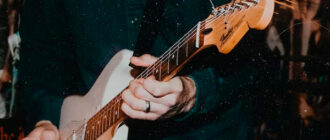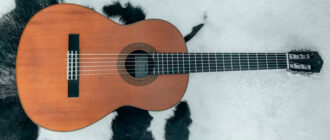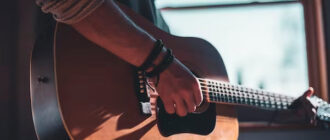
How to Record Yourself Playing Guitar: Are you a guitarist looking to record your playing but don’t know where to start? Recording yourself playing guitar can be a great way to capture your musical creativity and improve your skills. Whether you’re playing acoustic or electric guitar, using an audio interface or just a microphone, there are plenty of ways to record your guitar and make great quality recordings. In this blog post, we’ll explore the best way to record yourself playing guitar at home, the equipment and software you need, and some tips to help you get started. So, grab your guitar and let’s record guitar music!
Table of Contents
How to record yourself playing guitar?
The first step to recording yourself playing guitar is to decide on the equipment you’ll need for the guitar recording. There are several options available depending on your budget and recording needs of guitar playing. Here are the basic steps to follow:
1. Download a Digital Audio Workstation (DAW)
A DAW is a software program that allows you to record, edit, and mix audio tracks. There are many free and paid options available for recording audio, such as Garageband, Audacity, and Pro Tools. Choose one that suits your needs and is easy to set up with any headphone set.
2. Set your project tempo
Before you start playing, set the tempo of your DAW project to match the speed of the song or riff you want to record and play along for the audio recording. This will ensure that your recording process stays in time with the rest of the music.
3. Position your microphone
If you’re using a microphone to record your guitar, position the mic in front of your guitar amp or acoustic guitar when recording guitar videos. Experiment with the placement of the mic to see what works best for you if you are recording an electric guitar at home. You might want to try placing the microphone off-axis to reduce direct sound and capture more of the room’s natural acoustics. Learn how to record after you have tried a few different methods and have figured out what you need to record a great audio quality in your home studio.
4. Wear a pair of headphones
Wearing headphones will allow you to hear the audio in real-time while you’re playing, which is important for ensuring you’re playing in time and staying in tune. It also prevents the microphone from picking up the sound of the guitar coming out of the speakers. Headphone using to record a song while playing the guitar is a great way to get a high-quality audio track even with medium-quality recording software.
5. Set your input levels
Before you start recording, make sure your input levels on the recording equipment are set correctly when playing songs at home. This will ensure that you have enough headroom and prevent digital distortion. Adjust the input levels until the signal is strong but not clipping. Find out how to record properly with instructions to the equipment.
6. Hit the record button
Once you’re all set up, hit the record button and start playing! You can record multiple takes and choose the best one later. Learn music recording with these simple steps and get started recording your own music or covers of other musicians without letting sound quality affect your recording.
How do people record their guitar?

Image by Angad Singh from Unplash
There are several ways to record your guitar, depending on your recording needs and budget. Here are some common methods. You need to start recording and figure out what is convenient for you specifically.
1. Using a microphone to record your guitar
This is a great way to capture the natural sound of your guitar and the room’s acoustics. You can use a condenser microphone for a high-quality sound or a dynamic microphone like the SM57 for a more focused sound. Position the microphone in front of your guitar amp or acoustic guitar and experiment with the placement to find the best sound. The advantage of recording with headphone is that you will be able to concentrate on playing more fully. If you’re looking to get more “in zone”, this is a variant for you. You’ll get more quality guitar playing and recording with headphone, so it’s worth getting them.
2. Using an audio interface to record your guitar
In the context of audio devices, Hi-Z inputs (or high impedance) are designed to handle high impedance signals, typically from instruments like guitars and basses. An audio interface allows you to connect your guitar directly to your computer and record the audio digitally. This method provides a high-quality sound and allows you to use plugins and effects in your DAW.
Choose an audio interface like the Focusrite Scarlett or the Presonus AudioBox that has at least one input for your guitar and one output for your headphones. Always listen back to your recordings, you might want to experiment with different sounds, and listening back will give you a better understanding of your sound. Then you can decide whether you want to change it or keep it close to the original song.
3. Using your phone to record your guitar
If you’re on a budget, you can use your phone to record your guitar. There are several apps available, such as Garageband for iOS and FL Studio Mobile for Android. Connect your guitar using a USB or lightning cable and start recording.
Tips

Image by Matthijs Smit from Unplash
– Experiment with different microphone placements to find the best sound for your guitar. In general, there are two types of microphones used today: condenser mic and dynamic mic.
– Use headphones to monitor your recording and ensure you’re playing in time and in tune.
– Record multiple takes and choose the best one later.
– Use direct monitoring to hear your guitar in real-time without any latency.
– Record the audio and video separately and use video editing software to sync them up. Everything you need to edit will be provided by the software.
Warnings
– Be careful with the input levels to prevent digital distortion.
– Make sure you have enough headroom to avoid clipping.
– Move the mic away from the guitar if you’re experiencing feedback.
– Don’t position the mic too close to the soundhole of an acoustic guitar to avoid boomy sound.
Recording yourself playing guitar can be a great way to improve your skills and capture your musical creativity. Whether you’re using a microphone, an audio interface, or your phone, there are plenty of ways to record your guitar at home. By following the tips and techniques outlined in this blog post, you’ll be able to make high-quality recordings and take advantage of all the benefits that come with home recording. So, go ahead, hit record, and let your musical creativity flow!






